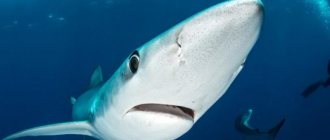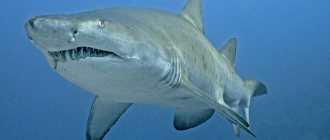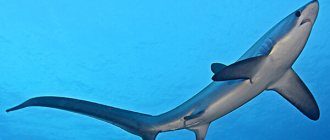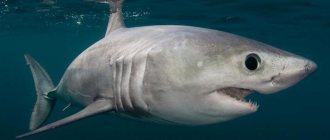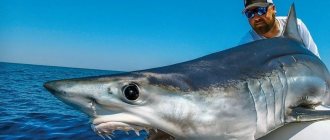Big-headed white-fin cat shark - what is its difference from other fish and its appearance? The description of the shark will tell us about this predator.
This shark lives on the southeastern coast of Australia, off the coast of. Tasmania and these are the only places where you can see it. The species epithet of this shark "albipinnum" (white+fin) refers to the white edges of the fins. This species did not have an official scientific description until 1994, and in 2008 it was already recognized as a full-fledged species with the name Cephaloscyllium sp. A. The first sample for research was caught off the coast of the island. Mariah, a meter-long male.
These predators reach a maximum length of 110 cm, 90 cm males are already sexually mature, while females reach the same state at a length of just under a meter.
Origin of the species and description
Photo: Cat Shark
The appearance of the most ancient ancestors of sharks dates back to the Silurian period; their fossils were found in layers dating back about 410-420 million years. A large number of life forms have been found that could become the ancestors of sharks, and it has not been reliably established from which of them they actually originated. Thus, despite the considerable number of finds of such ancient fish as placoderms and hybodus, the early evolution of sharks has been poorly studied, and much remains unknown. Only by the Triassic period does everything become much clearer: at this time, species exactly related to sharks already lived on the planet.
They did not survive to this day and were very different from modern sharks, but even then this superorder achieved prosperity. Sharks gradually evolved: calcification of the vertebrae occurred, due to which they began to move much faster; the brain grew due to the areas responsible for the sense of smell; jaw bones were transformed. They became more and more advanced predators. All this helped them survive during the Cretaceous-Paleogene extinction, when a significant part of the species that inhabited our planet simply disappeared. After it, sharks, on the contrary, reached even greater prosperity: the extinction of other aquatic predators freed up new ecological niches for them, which they began to occupy.
Video: Cat Shark
And to do this, they had to change greatly again: it was then that most of the species that still live on Earth were formed. The first of the cat shark family, however, appeared earlier: about 110 million years ago. It seems that it is from this that the rest of the carchariformes originate. Because of this antiquity, many species belonging to this family have already become extinct. Fortunately, the common catshark is not in danger of extinction. This species was described by C. Linnaeus in 1758, the name in Latin is Scyliorhinus canicula. Ironically, if in Russian the name is associated with a cat, then the specific name in Latin comes from the word canis, that is, dog.
Interesting fact: When felids are in danger, they inflate themselves by filling their stomachs. To do this, the shark bends into a U shape, grabs its own tail with its mouth and sucks water or air inside itself. When it is subsequently deflated, it makes loud sounds similar to barking.
Genera [edit]
Small spotted catshark Small spotted catshark, Scyliorhinus canicula
The family contains 17 genera and over 150 species [1], making it the largest family of sharks. [3]
- Apristur
Garman, 1913. - Asimbolus
Wheatley, 1939 - Atelomikter
Garman, 1913 - Aulohalaelurus
Fowler, 1934 - Bythaelurus
Compagno, 1988 - Cephaloscyllium
T. N. Gill, 1862 - Cephalur
Bigelow and Schroeder, 1941 - Figaro
Wheatley, 1928. - Galeus
Rafinesque, 1810 - Halaelurus
T. N. Gill, 1862 - Haploblepharus
Garman, 1913 - Holohalaelurus
Fowler, 1934 - Parmathur
Garman, 1906. - Pentanchus
H. M. Smith and Radcliffe in Smith, 1912 - Poroderma
A. Smith, 1838 - Schroederichthys
A. Smith, 1838 - Scilorine
Blaineville, 1816
Appearance and features
Photo: What a cat shark looks like
It is small in length, on average 60-75 cm, sometimes reaching a meter. Weight is 1-1.5 kg, the largest individuals have 2 kg. Of course, in comparison with really large sharks, such sizes seem very small, and these fish are sometimes even kept in aquariums. It still requires a large container, but its owner can boast of a real live shark, albeit a small one, but it looks like a shark. Although not so predatory, primarily due to its short and rounded muzzle. There are also no prominent fin blades characteristic of large sharks; they are relatively underdeveloped.
The caudal fin is quite long in comparison with the body. The catshark's eyes do not have a nictitating membrane. Her teeth are small and not sharp, but there are a lot of them, they are located in the jaw row after row. Males stand out because their teeth are larger. The body of the fish is covered with small scales; they are very hard; if you touch them, the sensation will be similar to touching sandpaper. The color of the cat shark is sandy, with many dark spots on the body. Her belly is light, with much fewer spots or no spots at all.
The coloring of other species, also belonging to the genus of cat sharks, may differ, as well as their length. For example, the South African species grows to 110-120 cm, its color is darker, and there are well-defined transverse stripes along the body. Other species also differ: some rarely grow up to 40 cm, others grow to a rather impressive 160 cm. Accordingly, they have different lifestyles, behavior, nutrition, enemies - here, unless otherwise indicated, an ordinary cat shark is described.
Keeping in an aquarium
To keep gray bamboo sharks, a large container is required (volume of at least 1500 liters). Sandy bottom is recommended. The aquarium should also have shelters (at least 1 large cave), vegetation and imitation reefs. Recommended water temperature is +22+28°C. You should feed them three times a week with food close to natural, that is, shrimp, worms, crabs and others. The water must be well supplied with oxygen, so a powerful filter is needed. Gray bamboo sharks are compatible with other fish of similar size. Large triggerfish, wrasse, pufferfish and coral fish are undesirable neighbors for sharks, as they can damage their eyes and skin.
Text author: wolfonokW7
Where does the cat shark live?
Photo: Cat shark in the sea
Mainly in the waters surrounding Europe, including:
- Baltic Sea – relatively rare;
- North Sea;
- Irish sea;
- Bay of Biscay;
- Mediterranean Sea;
- Sea of Marmara.
Also found along West Africa as far as Guinea. In the north, the limit of distribution is the coast of Norway, where relatively few of them are found, yet the water becomes too cool for this species. It does not live in the Black Sea, but sometimes it swims in and is seen near the Turkish coast. In the Mediterranean Sea, most of this fish is found near Sardinia and Corsica: presumably, in the vicinity of these islands there are areas where it breeds.
Another area of concentration of cat sharks off the western coast of Morocco. In general, they are common in waters lying in temperate and subtropical climates, as they do not like too warm weather. They live on the bottom, which is why they inhabit areas of the shelf where the depth is shallow: they feel most comfortable at a depth of 70-100 m. But they can live both at shallower depths - up to 8-10 m, and at greater depths - up to 800 m. Typically, young sharks stay further from the shore, at greater depths, and as they grow, they gradually move closer to it. When the time comes to reproduce, they swim out to sea to the very edge of the shelf, to where they themselves were born.
They settle in places with a rocky or sandy bottom, they like to stay in silty areas where a lot of algae and soft corals grow - this especially applies to juveniles. Other species of cat sharks can be found in different parts of the planet, they inhabit all oceans. For example, several live in the Caribbean Sea: the Caribbean cat shark, the Bahamian shark, and the Central American shark. Japanese is found off the east coast of Asia, and so on.
Now you know where the cat shark is found. Let's see what she eats.
Links[edit]
- ^ ab Froese, Rainer and Daniel Pauly, eds. (2009). "Scyliorhinidae" at FishBase. Version January 2009
- ^ abc Compagno, L.J.; Dando, M.; Fowler, S. L. (2005). Sharks of the world
. Princeton University Press. paragraph 186. - ^ ab Michael, Scott W. (March 2004). "Sharks at home." Magazine "Aquarium fish"
. pp. 20–29. - Smith, M.M.; Frase, G. J.; Chaplin, N.; Hobbs, C.; Graham, A. (7 April 2009). "Repeated pattern of sonic hedgehog expression in catshark dentition reveals phylogenetic template for jawed vertebrates". Proceedings of the Royal Society B: Biological Sciences
.
276
(1660): 1225–1233. DOI: 10.1098/rspb.2008.1526. PMC 2660956. PMID 19141424. - Dassoulet, Helen; Lewis, Paula; Bey, Marianne; Maas, Richard; McMahon, Andrew P. (24 October 2000). "Sonic Hedgehog regulates tooth growth and morphogenesis." Development
.
Company Biologists LLC 127
(22):4775–4785. ISSN 1477-9129. PMID 11044393. - "Scientists discover 180 species of luminous fish". Retrieved July 8, 2015.
- "Sharks light up in neon colors". video.nationalgeographic.com
. Retrieved July 8, 2015. - Sparks, John S.; Shelly, Robert C.; Smith, W. Leo; Davis, Matthew P.; Chernov, Dan; Pieribone, Vincent A.; Gruber, David F. (January 8, 2014). "The hidden world of fish biofluorescence: a phylogenetically widespread and phenotypically variable phenomenon". PLoS ONE
.
9
(1):e83259. DOI: 10.1371/journal.pone.0083259. PMC 3885428. PMID 24421880. - Gomes, U. L.; Signori, C.N.; Gadig, O. B. (2006). "Report on the smallfin catshark Apristurus parvipinnis Springer & Heemstra (Chondrichthyes, Scyliorhinidae) in the western South Atlantic with notes on its taxonomy." Panamjas
. - Farina, Jose M.; Ojeda, F. Patricio (3 May 1993). "Abundance, activity and trophic characteristics of the red catshark, Schroederichthys chilensis, on the Pacific temperate coast of Chile." Kopeya
.
1993
(2):545–549. DOI: 10.2307/1447159. JSTOR 1447159. - ^ ab Able, kW; Flesher, D. (1991). "Distribution and habitat of the chain blenny Scyliorhinus retifer in the Mid-Atlantic Bight." Kopeya
.
1991
(1):231–234. DOI: 10.2307/1446270. JSTOR 1446270. - Wearmouth, V.J.; Southall, E. J.; Morritt, D.; Thompson, R. Cuthill, IC; Partridge, J.C.; Sims, D. W. (2012). "Year-Round Sexual Harassment as a Behavioral Mediator of Vertebrate Population Dynamics". Ecological monographs
.
82
(3):351–366. DOI: 10.1890/11-2052.1. - Castro, J. I.; Bubucis, P. M.; Overstrom, N. A. (1988). "Reproductive biology of the chain dog, Scyliorhinus retifer". Kopeya
.
One thousand nine hundred and eighty eight
(3): 740. DOI: 10.2307/1445396. JSTOR 1445396.
What does a catshark eat?
Photo: Black catshark
The diet of this fish is varied and includes almost all small animals that it can catch.
These are small organisms that live near the bottom, such as:
- crabs;
- shrimps;
- shellfish;
- echinoderms;
- tunicates;
- polychaete worms.
But the menu of these sharks is based on small fish and decapods. As they grow, the nutritional structure changes: young people mainly eat small crustaceans, while adults more often catch mollusks and large decapods and fish.
Their teeth are well adapted for cracking shells. Large cat sharks often hunt squid and octopuses; even an animal of comparable size to them can become their prey. Sometimes they are overly aggressive and try to attack even larger prey, and such attempts can end badly for them. The attacks themselves are usually carried out from an ambush, trying to catch the victim at the most inconvenient moment for him. If this does not work out and she manages to escape, they usually do not go in pursuit, although sometimes there are exceptions if the shark is too hungry. Also in these cases, it can feed on the larvae of other marine life, although it usually ignores them.
The cat shark's menu also includes plant foods: algae and several types of soft corals, which is why it often settles in areas rich in such vegetation. However, plants do not play a big role in its nutrition. In summer, this fish eats much more actively than in winter.
Interesting fact: According to researchers from Cranfield University, catsharks respond to rewards with food and seek to receive them by performing the same actions as they did before they were fed. They remember this for quite a long time, up to 15-20 days.
Model of the organism[edit]
S. canicula
well suited for comparative analysis of gastrulation for several reasons.
- It is collected in large quantities on all the coasts of Europe, and is the only known species of elasmobranchs from which individuals at any stage of development can be obtained in abundance at any time of the year. [5]
- Fertilization is internal, but eggs are laid early in development, before the formation of the blastocoel. Once established, they can develop normally in the laboratory, simply in oxygenated sea water. [14]
- The size and accessibility of the embryo facilitates analysis.
- Five well-characterized stages can be distinguished between the onset of gastrulation and the onset of neurulation. [14]
Features of character and lifestyle
Photo: Asian catshark
These sharks do not like the sun and, when it hangs high above the horizon, they prefer to rest on the bottom in shelters and gain strength. Underwater caves, piles of snags or thickets serve as such shelters. Only when dusk comes do they begin to hunt, and their peak activity occurs at night. At the same time, they do not have night vision, and in general it is poorly developed, but rely on another sense organ. These are receptors (ampoules of Lorenzini) located on the muzzle. Every living organism that swims by inevitably generates electrical impulses, and sharks, with the help of these receptors, detect them and accurately recognize the location of their prey.
They are excellent hunters: they are able to make quick leaps, change direction sharply, and have excellent reactions. They spend most of the night slowly swimming in the vicinity of their shelter at the bottom and looking for prey. They attack the small ones immediately, but before attacking the large ones they can hide in ambush and wait until the best moment comes. They most often hunt alone, but not always: they sometimes gather in flocks, primarily in order to hunt large animals together. But such schools usually do not last long: most of the time, cat sharks still live alone.
Sometimes several individuals live close to each other and get along well. Conflicts can occur between cat sharks, and in such cases one of them drives the other away. Despite their rather aggressive nature, they are not dangerous to humans: their teeth are too small to cause serious damage, and they are not the first to attack. Even if a person himself swims too close and disturbs a catshark, most likely it will simply swim away and hide.
Threat level[edit]
S. canicula
- one of the most common elasmobranchs in the northeastern part of the Atlantic and Mediterranean seas. It is regularly caught in coastal fisheries, but much of what is caught by commercial and recreational fishermen is discarded. Studies have shown that the survival rate after a blowout is extremely high, about 98%. Although localized depletion may have occurred in some areas, studies have shown that populations are stable or even increasing throughout much of the range. However, continuous monitoring of landing and discarding data is important to avoid any future decline. This species is currently listed as of least concern on the IUCN Red List of Threatened Species because there is no evidence that the global population has declined significantly. Since 2003, these sharks have been released annually into the Gylmarn fjord in Sweden from the Havets Hus public aquariums in Lysekil. Since 2003, more than 90 sharks have been released, of which one was found in southern Norway 10 years after release. This means that these sharks can reach at least 14 years of age. [15]
Social structure and reproduction
Photo: Coral catshark
Cat sharks are predominantly solitary, rarely and briefly gathering in small groups, therefore they have no social structure. They can spawn at any time of the year, most often it depends on the habitat. For example, in the Mediterranean Sea, spawning occurs in the spring, and in some individuals at the end of the year. In the north of their range, spawning begins in late autumn and can last until mid-summer; off the west coast of Africa, the first sharks spawn in February, and the last in August - and so on, this period can fall in a variety of months.
In any case, the female lays eggs no more than once a year. There are usually 10-20 of them, they are in hard capsules, very oblong in shape: they reach 5 cm in length and only 2 cm in width. At the ends of these capsules there are threads up to 100 cm long, with their help the eggs cling to something , for example, stone or seaweed. The development of the embryo inside the capsule lasts 5-10 months, and all this time it remains defenseless. At first, it helps that it is transparent, so it is very difficult to notice it in the water. Then little by little it becomes milky in color, and shortly before the end of the development period it turns yellow or even acquires a brown tint.
At this moment, the embryo is in greatest danger. Immediately after hatching, the fry are 8 cm or slightly longer in length - interestingly, they are larger in cold waters than in warm ones. From the very first days they resemble adults, only the spots are much larger relative to the size of the body. At first, they eat up the remains of the yolk sac, but soon they have to look for food on their own. From this time on they become small predators. They can spawn from the age of 2, by which time young cat sharks grow up to 40 cm. They live for 10-12 years.
Notes
- Reshetnikov Yu. S., Kotlyar A. N., Rass T. S., Shatunovsky M. I.
Five-language dictionary of animal names. Fish. Latin, Russian, English, German, French. / under the general editorship of academician. V. E. Sokolova. - M.: Rus. lang., 1989. - P. 24. - 12,500 copies. — ISBN 5-200-00237-0. - Nakaya, K. & McCormack, C.
2009. Apristurus sibogae. In: IUCN 2011. IUCN Red List of Threatened Species. Version 2011.2. . Downloaded on 09 May 2012.
Natural enemies of catsharks
Photo: What a cat shark looks like
Eggs and fry are most at risk, but, unlike their larger relatives, even an adult cat shark is not so large that it is not afraid of anyone in the sea. It is preyed upon by larger fish, primarily Atlantic cod - this is its worst enemy.
It has a significant superiority in size and weight, and most importantly: there are a lot of them in the same waters in which the cat shark lives. In addition to cod, their frequent enemies are other, larger sharks. As a rule, they are faster, and therefore the cat shark can only hide from them.
There are many people who want to dine on them, so the life of these predators is very dangerous, and during the hunt they need to constantly monitor the situation around them so as not to inadvertently become prey themselves. In addition to this, their enemies include many parasites. The most common among them: kinetoplastids of several species, cestodes, monogenea, nematodes and trematodes, copepods.
People are also dangerous for them, but not too much: they are usually not caught on purpose. They can be caught in nets or bait, but are often released because the meat of these sharks is considered unpalatable. The cat shark is tenacious and, even if damaged by a hook, almost always survives such cases.
Is it dangerous to people?
This species is absolutely safe for humans . Not a single case of shark aggression towards humans has been recorded. Often they just tried to swim away. But for her, people are extremely dangerous, since some fishermen are engaged in catching her. Although, if she gets caught in the net by accident, she is often released back. also use the bodies of cat sharks for their research . Since this type of shark is the most common among elasmobranchs. According to the results of research by the International Union for Conservation of Nature, this species has the status of “Least Concern”.


